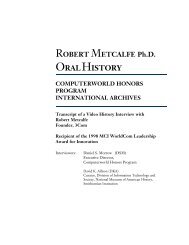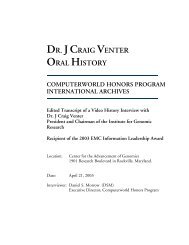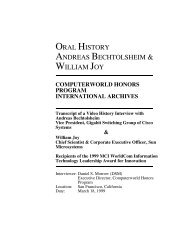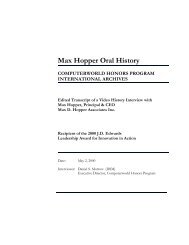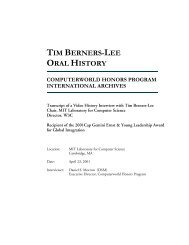NATHAN MYHRVOLD PhD ORAL HISTORY - The Computerworld ...
NATHAN MYHRVOLD PhD ORAL HISTORY - The Computerworld ...
NATHAN MYHRVOLD PhD ORAL HISTORY - The Computerworld ...
You also want an ePaper? Increase the reach of your titles
YUMPU automatically turns print PDFs into web optimized ePapers that Google loves.
We then had a two week long meeting arguing about things like, you get all the<br />
various parts of the technology, and what do we have to contribute, and what do they<br />
have to contribute? By the end of the two weeks, we had a deal that Microsoft and<br />
IBM would continue to work together. That was the first thing I did.<br />
After that I was involved sort of two things in parallel. I was a development manager<br />
for graphics on Windows 2.0. That was the last unsuccessful version of Windows.<br />
<strong>The</strong>y got me off boom, you know. So that was exciting. We changed the graphics<br />
algorithms for all of the things in Windows 2.0, but we had a goal of making every<br />
operation a factor or two faster even on the same computer. We actually did it<br />
without a whole bunch of patents, and making it faster was very crucial because<br />
Windows 2 0 was the platform on which a couple of the most successful windows<br />
applications launched, both us and other companies. It’s the platform on which Ray<br />
Ozzie and a bunch of people at Iris Associates wrote Notes. It was a platform at<br />
which Ted Johnson and a bunch of people at Aldus, which is right across the way<br />
here in Seattle, wrote Page Maker for Windows.<br />
That was also when Microsoft wrote Excel and Word. Those applications were very<br />
crucial to the future success of Windows. Windows 2.0 was never a very successful<br />
platform. I think Windows 1.0 came in 1985, and it was a joke cause far as most<br />
people were concerned. In fact there was a big thing at Comdex where they had a<br />
roast of the project and all these people came up to make fun of it. Windows 2.0 was<br />
more credible but it still was not our best seller by any stretch.<br />
Windows 3.0 came out in 1990. So Windows was a product for five years before it<br />
was successful. Those were long, hard, difficult years for those of us that were<br />
involved in building it, but we believed so much in the technology. We believed that<br />
graphical use interface was the future, but we did things in retrospect. You’d say,<br />
“My God what were we thinking.” As one example, in Windows 2.0 we couldn’t<br />
assume that there was a hard disk machine because too many machines didn’t have<br />
hard disks. So there was a card that came in the box with Windows 2.0 that had the<br />
instructions for how you should lay your floppy disks out on the desk, so when asked<br />
you to swap a disk in and get more things, you could shuffle them in and do this little<br />
shuffle to keep it straight.<br />
Nathan Myhrvold<br />
Oral History<br />
22




